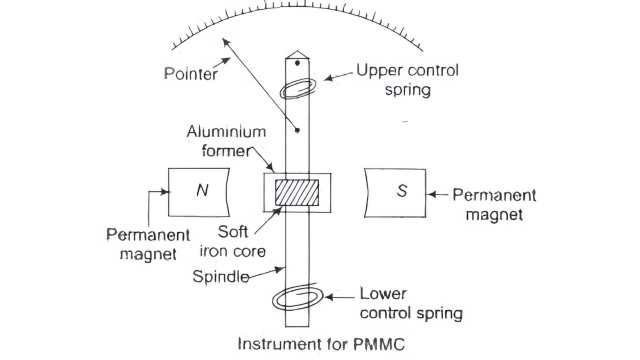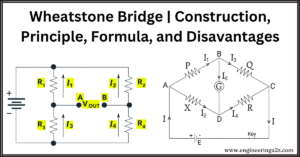
Table of Contents
PMMC
A permanent magnet moving coil instrument can measure DC voltage & current. The working principle of these instrument is the same as that of the D’ Arsonval type of galvanometer, the difference being that a direct reading provided with a pointer & a scale.

Construction of PMMC Instrument
It has a permanent shoe magnet & a rectangular coil having large number of turns wound on a light aluminium or copper former. A iron core is provided inside the former to provide an easy path for the magnetic lines of force.
The coil is mounted on a spindle. The springs are used to supply current to the moving coil. The pointer is provided on the spindle to indicate the magnitude of quantity being measured.
- Deflecting torque is provided by the force acting on the coil when current flow through it.
- Controlling torque is provided by the springs provided on the spindle.
- Damping torque is provided by eddy current induced in the iron core of the moving coil.
PMMC Instrument Working Principle
When operating current flows through the coil, it produces a magnetic flux. Direction of magnetic flux depends upon the direction of current flowing through the coil. Thus the direction of force acting on a moving coil & hence direction of movement of coil depends upon the direction of current through the coil. These instrument can be used for measurement of DC only.
If the direction of DC current flow through the coil is reversed, the direction of deflecting torque & movement of pointer will also be reversed.
Eddy current induced in the iron core of moving coil produce damping torque.
Advantages of PMMC Instrument
- Scale of these instrument is uniform.
- These are accurate & reliable.
- Eddy current damping is quit effective.
- There is no effect of stray magnetic field as it has a strong permanent magnet.
- These instrument require low driving power, hence their power consumption is low.
Disadvantages of PMMC Instrument
- These instrument can operate DC supply only.
- These are costlier than moving iron instrument.
Related Posts
- Wheatstone Bridge | Construction, Principle, Formula and Disadvantages
- What is Thermocouple | Construction & Working Principle
- Wattmeter | Dynamometer type Wattmeter
- Vortex Flow Meter | Design, Working Principle, Accuracy and Rangeability
- Ultrasonic Flow Meter | Principle Operation, Working, and Installation
- Strain Gauge | Working | Types | Applications and Advantages












Comments (2)
I love your content 🙂
Awesome! Its genuinely amazing paragraph, I have got much clear idea
regarding from this post.